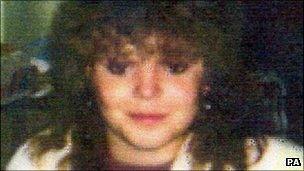Lynette White case: Forensics 'led to Jeffrey Gafoor'
- Published

Lynette White was stabbed more than 50 times in the flat where she worked
Forensic tests identified the killer of Lynette White 15 years after she was stabbed to death in a Cardiff flat, a jury has heard.
By then three men had been jailed for her murder and freed on appeal in 1992.
In 2003 a familial link connected Jeffrey Gafoor to the scene, four years after a new forensics probe began. He admitted the murder and was jailed.
Eight ex-police officers deny perverting the course of justice in a trial at Swansea Crown Court.
Five men, who became known as the Cardiff Five, were originally tried and three of them Stephen Miller, Yusef Abdullahi and Tony Paris were convicted and jailed for life in 1990.
The Cardiff Three as they became known were freed on appeal two years later.
Miss White, a prostitute, was stabbed more than 50 times inside the flat which she used to entertain clients in the early hours of 14 February 1988.
The jury in the trail of the former police officers heard how the main suspect, who became known as Cellophane Man, was among 14 "unknown males of interest" whose DNA had been found inside flat at James Street.
But as his DNA was found in more locations, including Miss White's clothing, he became the man police wanted to identify.
By 2003 a familial link was discovered to Gafoor and after his arrest further tests showed he was the man detectives had been trying to identify.
Presented with the evidence, Gafoor admitted murder and was jailed for life.
Dr Angela Gallop, a forensic scientist, said she became involved in the investigation in 1999 and began carrying out tests on more than 100 items, including Miss White's clothing.
DNA profile
She said she was interested in finding the DNA of people who did not belong in the flat or who were, at that time, unknown to the police.
Dr Gallop said one of the biggest problems was actually locating the exhibits that had been removed from the flat 11 years earlier.
An incomplete DNA profile was obtained from blood on a piece of cellophane found on the floor next to Miss White's head.
Although the profile was not full it was clear that it came from an unidentified male and was therefore of interest.
He became of even more interest when another incomplete, but matching, profile was found in blood on a passage wall and then another on Miss White's left sock.
Scientists made further progress when more samples were found on Miss White's jacket and jeans.
And blood left next to the letter-box on the outside door of another property was matched to him with a one in a billion chance it could have come from someone else.
There was also evidence that the blood was mixed with the DNA of Miss White.
The trial continues.
- Published12 October 2011
- Published11 October 2011
- Published5 October 2011
- Published4 October 2011
- Published29 September 2011
- Published28 September 2011
- Published26 September 2011
- Published21 September 2011
- Published20 September 2011
- Published13 September 2011